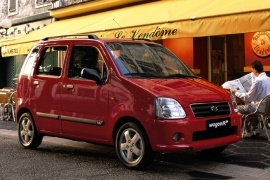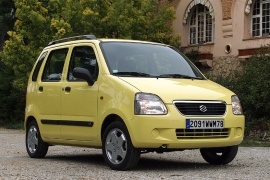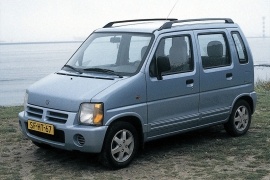SUZUKI Wagon R Models/Series Timeline, Specifications & Photos
First production year: 1997
Engines: Gasoline, Diesel
Body style: Hatchback
On the Japanese market, the vehicles with a cubic design proved to be successful. Still, on the European market, the result was lower than expected.
Suzuki and Opel joined their forces to produce and sell a car in Europe based on Japanese ideas. The result was the Wagon R/Agila duo, built at Suzuki's plant from Hungary. On paper, the car was great: it offered a good fuel-efficiency, room for five, and a big trunk.
The biggest problem was with the design. With a short length and a tall construction, the Wagon R was far to be considered handsome by the European customers. A flat and tall fascia with an almost non-existent front overhang was very useful in tight parking spots. In the back, a well-placed mirror could help the driver see the rear bumper.
The interior was minimalist, with a two-level dashboard, which featured a lower shelf for both front passengers. To help the dealers most of the stereo units were dealer installed from aftermarket suppliers. On the base trim level, there were four wind-up side windows and no air-conditioning. These two features were available only on the top trim level.
Under the hood, the last generation of the Suzuki offered the Wagon R with a choice of gasoline and diesel engine. The base trim-level was powered by a Japanese three-cylinder, while Opel provided the four-pot. The diesel version was a joint project between GM and Fiat. All versions were paired to a five-speed manual.
Suzuki designed the Wagon R for the Japanese market, brought it to Europe, and built it in its Hungarian factory on the same assembly line with Opel/Vauxhall Agila.
The three vehicles were a fine example of badge engineering combining Suzuki kei-car experience and Opel's drivetrains. Since the Japanese carmaker didn't have the same dealer network as GM Europe, the joint venture worked excellently, and the three brands combined sold over 400,000 units from its first generation. In 2000, the carmaker introduced a facelifted version. As usual, only the front fascia and the badge on the steering wheel were different.
While the exterior design was rather dull, customers mostly bought the Suzuki Wagon R for its practicality. The small MPV was ideal for crowded city transportation thanks to the low fuel consumption it offered. While other carmakers offered city cars in a 3-door configuration, the Wagon R's extra two doors helped rear passengers' ingress and egress.
Inside, the cabin was fitted with good quality materials. Everything was well laid out. Its controls were intuitively placed and easy to action, while the black on white gauges was easy to read. The carmaker didn't offer a wide choice of options for the interior, but in that segment, most customers asked just for cloth upholstery.
Suzuki offered the Wagon R with a choice of two engines: a 1.0-liter or 1.2-liter gasoline, the latter developing 75 hp. Both versions were paired to a 5-speed manual transmission.
Suzuki introduced the second generation of the Wagon R in 1997 on the Asian market, and it managed to offer a roomy interior for a tiny city vehicle.
With its Japanese kei-car segment experience, Suzuki tried to export the Wagon R on several other markets. Its idea was to offer the small MPV with larger engines than those provided in Japan, where the kei-segment was limited to 600 cc.
There wasn't too much styling involved in the Wagon R. It was just a cube with another cube at the front and a pair of squared headlights. The only imaginative test for the design team was to create an attractive grille and bumper. But both of them had to fit inside the exterior kei-segment limits. While practical within city limits, the Wagon R wasn't at home on twisty roads or highways. Due to its unusual height, the car's stability was affected by cross-winds.
Inside, the cabin was fitted with good quality materials. Everything was well laid out. The controls were intuitively placed and easy to action, while the black letterings on white gauges were easy to read. The cloth upholstery was available in different colors to personalize the Wagon according to the buyer's taste.
Suzuki installed a choice of two engines under Wagon R's hood: a 1.0- and a 1.2-liter gasoline engine. They provided 65 hp and 70 hp, respectively.


